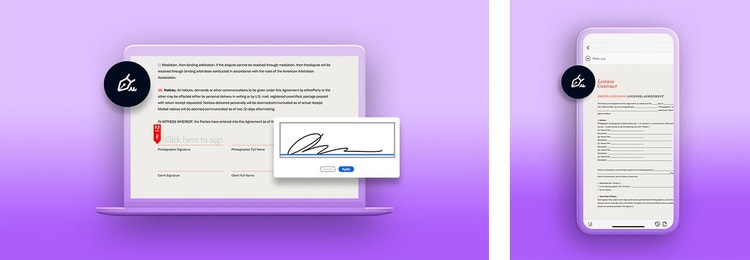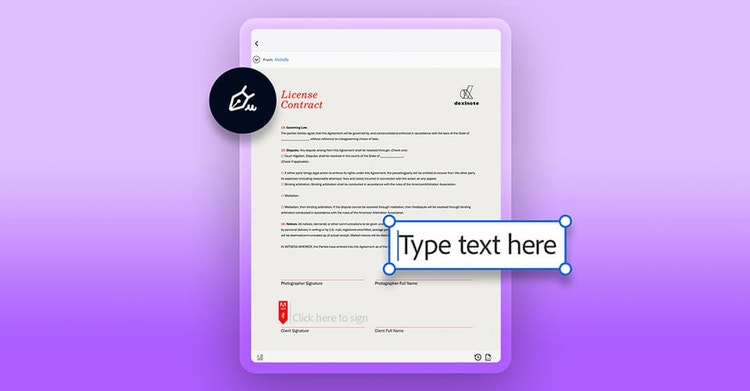Adobe Acrobat Sign
License agreement (license contract) definitions & overview.
Use this type of contract when you want to get the rights to someone else’s protected property. Learn how to create a thorough contract so you can make an agreement that’s mutually beneficial.

What is a license contract?
A license contract, also known as a license agreement or licensing agreement, is a type of contract where one party (the licensor) grants another party (the licensee) the right to produce, use, sell, and/or display the licensor’s protected material.
Protected material can include physical property, but it most often refers to intellectual property like copyrighted work, trade secrets, trademarks, brand names, and patents. License contracts don’t grant the licensee ownership of the asset, just the right to use it.
How do licensing agreements work?
Any time you want to use someone else’s property, you need to ask for permission — and often pay a fee as well. That’s essentially what a license agreement is, no matter the scale of the agreement or product. For example, a music-streaming platform needs to license an artist’s new album if they want to make it available on their platform, and a clothing company needs permission to place a sports team logo on merchandise to make officially licensed products.

Benefits of license contracts.
License contracts are incredibly valuable to companies who own the rights to a product but don’t have the ability to manufacture it on their own. They also allow the licensor to control how and in what context their work appears.
For example, if a small business creates a proprietary technology and secures intellectual property rights for their work, they profit from selling licensing rights to their product, while the company buying the rights saves time and money by not having to create their own product from scratch.
Not only is asking for permission via a license contract the right thing to do, it will also protect both the licensee and licensor should any legal issues arise.

What to include in your license contract.
Every contract looks different, but below is a list of common points to consider and prepare for as you draw up your contract. Get started in a few clicks with a contract template for Adobe Acrobat Sign. And always seek legal advice from an attorney before you put your contract into action.
What is being licensed
List exactly what is on the table to be licensed — and be as specific as possible.
Exclusivity
Determine whether the contract will provide an exclusive or nonexclusive license. With exclusive rights, the licensor grants sole permission to use the licensed property to the licensee, but in a nonexclusive arrangement there may be several licensees.
Duration
Define how long the license is valid for, the terms of renewal, and how one party can end the contract early if necessary.
Location
Be specific about the geographic locations where someone can license the product. Depending on the product or the region where it will be distributed, the applicable laws may change. Plan for this ahead of time to save both parties the hassle down the road.
Payment
Outline how and when the licensor will get paid. Compensation is often in the form of royalty payments, which are usually a percentage of sales or a fixed royalty rate per unit sold.
Joint ventures
If the license is nonexclusive, the contract should also lay out the licensee’s and licensor’s rights to sublicense or form a joint venture. For example, a distributor may want to hire a marketing company to help promote the product. You must grant or deny permission for third-party partnerships like these in the license contract.
Confidentiality clause
If you share sensitive information with the licensee, such as a trade secret, include a nondisclosure agreement to protect this confidential information. This clause should also outline the consequences if a breach of confidentiality occurs.
Indemnification clause
An indemnification clause is like a disclaimer or liability waiver against any harm or damages to property during the agreement. One party agrees to pay the fees, legal expenses, and other costs that may fall to the other party as a result of the work.
Dispute resolution
Both parties need to know how to handle a dispute, should any arise, before you enter an agreement. The contract should also outline what breaches of contract could void the entire agreement. Arbitration, mediation, or court intervention are the most common routes of dispute resolution.

Create license contracts with Adobe.
Sail through contract creation, negotiation, and signing with Acrobat Sign. Digital documents mean you can skip the time and costs of mailing physical paperwork back and forth. Collaborators can comment and edit in real time, and when you’re ready to send your agreement for signature, you can do it in a single click. Signers can sign from any device, and you’ll be notified when the agreement is signed.
